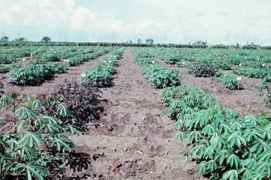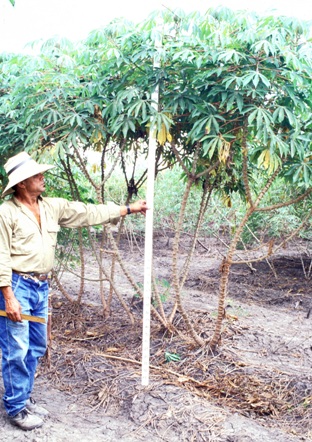Characterization of cassava genetic resources
Contributors to this page: CIAT, Colombia (Daniel Debouck); IITA, Nigeria (Dominique Dumet); Bioversity International/ILRI, Ethiopia (Alexandra Jorge); independent consultant (Clair Hershey); INIA, Peru (Llerme Rios); Bioversity International, Rome (Adriana Alercia).
Characterization of cassava germplasm (and many clonal crops) is particularly important for the following purposes:
- To verify the genetic integrity of material kept under the in vitro conservation technique (especially after several years of conservation).
- To detect mixtures of materials.
- To identify genetic duplication (redundancy of material).
|
Contents: |
Planting and cultural practices for characterization
Clonal crops are usually characterized during field regeneration. See also the regeneration page for the complete details of cultural practices.
|
|
Environment
- Material should be characterized in an environment that is highly suited to cassava growth and development, and where biological and environmental problems are minimized, so that there are no confounding effects on the expression of traits used for characterization.
Plot size
- Spacing between plants 1-1.5 m.
Sampling area/border area
- 2.2 m, 1.5 m and 1.0 m between adjacent plots for high, intermediate and low vigour groups (to allow the scoring of individual plots and avoid mixing by lodging).
Plant density
- Maximum 1 plant per m2.
Replications
- Normally unreplicated entries with control varieties regularly replicated (replication of only control varieties is sufficient for normal assessment of highly heritable morpho-agronomic traits; this practice is more economical and thus allows the screening of more accessions).
- For special-purpose characterization for more rigorous statistical analysis, full replication is necessary.
Standard check cultivars
- Local standard cultivars should be used as a reference, especially for pest and disease screening.
Frequency of standard checks
- Random or after every 20 accessions.
Morphological descriptors for characterization
The list of suggested descriptors below is from Fukuda et al. (2010), who developed a descriptor list for IITA. This is based on descriptors used by both CIAT (Colombia) and EMBRAPA (Brazil), and thus encompasses the world’s major cassava collections. The publication includes a full complement of colour photos to facilitate understanding of the states of each descriptor.
Descriptors to be scored at three months after planting
- *1. Colour of apical leaves.
- *2. Pubescence on apical leaves.
Descriptors to be scored at six months after planting
- 3. Leaf retention.
- *4. Shape of central leaflet.
- *5. Petiole colour.
- *6. Leaf colour.
- 7. Number of leaf lobes.
- 8. Length of leaf lobe.
- 9. Width of leaf lobe.
- 10. Ratio of lobe length to lobe width of central leaf lobe.
- 11. Lobe margins.
- 12. Petiole length.
- 13. Colour of leaf vein.
- 14. Orientation of the petiole.
- 15. Flowering.
- 16. Pollen.
Descriptors to be scored at nine months after planting
- 17. Prominence of foliar scars.
- 18. Colour of stem cortex.
- 19. Colour of stem epidermis.
- *20. Colour of stem exterior.
- 21. Distance between leaf scars.
- 22. Growth habit of stem.
- 23. Colour of end branches of adult plant.
- 24. Length of stipules.
- 25. Stipule margin.
|
|
Descriptors to be scored at harvest
- 26. Fruit.
- 27. Seed.
- 28. Plant height.
- 29. Height to first branching.
- 30. Levels of branching.
- 31. Branching habit.
- 32. Angle of branching.
- 33. Shape of plant.
- 34. Number of storage roots/plant.
- 35. Number of commercial roots/plant.
- 36. Extent of root peduncle.
- 37. Root constrictions.
- 38. Root shape.
- *39. External colour of storage root.
- *40. Colour of root pulp (parenchyma).
- *41. Colour of root cortex.
- 42. Cortex: ease of peeling.
- 43. Texture of root epidermis.
- 44. Root taste.
- 45. Cortex thickness.
- *46. Dry matter content.
- 47. Starch content
- 48. Harvest index.
- *49. Cyanogenic potential.
- *50. Postharvest deterioration.
- *Total fresh weight of storage roots per plant (not included in IITA descriptors).
*Descriptors in the list of key access and utilization descriptors developed by Bioversity International and CIAT (2009).
In addition to the above, any other local quality traits of importance could be included. New traits identified by industry should be considered for inclusion, such as the ratio of amylose to amylopectin.
Pictures for characterization
Sufficient detail should be captured in images to taxonomically identify the plant and demonstrate the traits that show variation.
- Take images for character(s) which may be difficult to describe verbally.
- Store in a database file linked to other characterization data.
Herbarium samples for characterization
- It is suggested they should be taken and stored for future reference during multiplication/regeneration, particularly for primitive and wild relatives (to verify the accession identity and to be used as reference material).
Molecular descriptors for characterization
- SSR, EST-SSR, AFLP, RAPD (these are the current more efficient techniques for genetic diversity analysis and to identify duplicates).
Cytological characterization
This type of characterization should be done in specialized laboratories. Cytological characterization, with current available techniques, is not likely to be broadly applied across all accessions of a collection, but might be targeted to sub-samples such as the core collection.
Recording information during characterization
- Reference to the trials (details of which will be stored in separate database with information on dates, place, trial layout, people in charge of trial, etc.).
- Fields selected from the cassava descriptor list.
References and further reading
Bertram RB. 1993. Application of molecular techniques to genetic resources of cassava (Manihot esculenta Crantz, Euphorbiaceae): interspecific evolutionary relationships and intraspecific characterization. University of Maryland. (PhD thesis).
Bioversity International, CIAT. 2009. Key access and utilization descriptors for cassava genetic resources. Bioversity International, Rome, Italy, International Center for Tropical Agriculture (CIAT), Cali, Colombia. Available here.
Fregene M, Vargas I, Ikea J, Angel F, Thome J, Asiedu RA, Akoroda MO, Roca WM. 1994. Variability of chloroplast DNA and nuclear ribosomal DNA in cassava (Manihot esculenta Crantz) and its wild relatives. Theor. Appl. Genet. 89:719-727.
Fukuda WMG, Guevara CL.1998. Descritores morfológicos e agronómicos para a caracterização de madioca (Manihot esculenta Crantz). [Morphological and agronomic descriptors for characterizing cassava (Manihot esculenta Crantz] Documentos CNPMF no. 78. EMBRAPA/CNPMF. Cruz das Almas BA, Brazil.
Fukuda WMG, Guevara CL, Kawuki R, Ferguson ME. 2010. Selected morphological and agronomic descriptors for the characterization of cassava. International Institute of Tropical Agriculture (IITA), Ibadan, Nigeria. 19 pp. Available from: http://www.iita.org/c/document_library/get_file?uuid=4530a72e-917d-4801-9239-cb0ee3a4dd4e&groupId=25357. Date accessed: 30 September 2010.
Gulick P, Hershey C, Esquinas Alcazar J. 1983. Genetic Resources for cassava and wild relatives. Series AGPG:IBPGR/82/111. IBPGR Secretariat, Rome. 56 pp.
Iwanaga M, Ayala ME, Ocampo CH, Hershey C. 1993. Caracterización de la colección de Colombia del germoplasma de yuca (Manihot esculenta Crantz) por electroforesis PAGE utilizando la isoenzima aß-esterasa. In: Clausen AM, editor. Recursos genéticos hortícolas, Instituto Nacional de Tecnología Agropecuaria, Balcarce, Argentina. pp. 244-258.
Ocampo CH, Hershey C, Iglesias C, Iwanaga M. 1993. Esterase isozyme fingerprinting of the cassava germplasm collection held at CIAT. In: Roca WM, Thro AM, editors. Proceedings of the First International Scientific meeting of the Cassava Biotechnology Network (CBN), Cartagena, Colombia, 25-28 August 1992, Cali, Colombia: CIAT (Working Document No. 123). pp. 81-89.
Ocampo CH, Angel F, Jímenez A, Jaramillo G, Hershey C, Granados E, Iglesias C. 1995. DNA fingerprinting to confirm possible genetic duplicates in cassava germplasm. In: Roca WM, Thro AM, editors. Proceedings of the Second International Scientific meeting of the Cassava Biotechnology network. Bogor, Indonesia, 22-26 August 1994. Working Document No. 150. Centro Internacional de Agricultura Tropical (CIAT). Cali, Colombia. pp. 145-151.
Roca, WM, Rodriguez JA, Roa J. 1983. Procedures for Recovering Cassava and Sweet potato Germplasm Distributed In vitro. Genetic Resource Unit CIAT Apartado Aéreo 6713 Call, Colombia S.A . Available from: http://www.scribd.com/doc/35771901/Manual-for-TC-Cassava-Sweet-Potato. Date accessed: 27 August 2010.
Comments
- No comments found







Leave your comments
Post comment as a guest